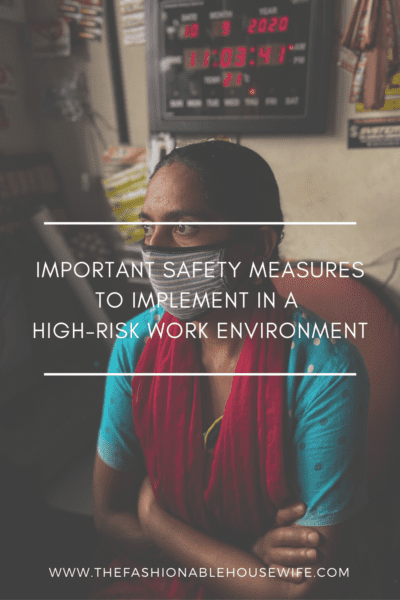
The levels of exposure to on-the-job perils vary from one career to another. For some, the risk is as low as a paper cut. For others, a day in the office involves ticking bombs, sirens, and life-changing stakes like Covid-19.
Whichever the case, it is incumbent upon you as an employer or administrator to implement sufficient safety protocols. What contingencies do you have in place for the worst-case scenarios? Have you considered what such situations would like? Is your staff fully aware of the risks they are exposed to?
Sounds daunting, doesn’t it? It doesn’t have to be. Here are some safety measures you can consider implementing if you run a high-risk workplace.
Safety Training
When your employees are sufficiently trained, it significantly reduces the chances of disastrous errors. Aim for practical and engaging safety training sessions. They impart more memorable lessons and can help staff understand the subject matter better. Group sessions are also recommended and they foster a sense of common responsibility for each other’s safety among employees.
In terms of content, staff should be equipped with emergency response protocols in addition to basic ‘dos and don’ts’. Such protocols can include:
- Exit strategies
- Which alarms codes to use during particular emergencies
- Contacting emergency response teams
- The type of immediate first aid to administer to a colleague in the event of certain mishaps
It is human nature to get complacent over time while performing repetitive procedures. To mitigate this, it is essential that training sessions are held fairly regularly to keep everyone on their toes. Refresher sessions are also useful in highlighting any new safety protocols in your line of business.
Protective Gear
A prime example of the importance of protective gear is the recent events surrounding the Coronavirus pandemic. Doctors and nurses have continuously been putting their lives on the line every time they begin a shift without proper personal protective gear. As a result, healthcare worker deaths in the line of duty have risen into the thousands across the globe.
The pandemic is just one representation, many more high-risk work environments suffer shortages of PPEs. Out of fear of losing their jobs, most workers keep risking their well-being every day to get the job done. In the end, they often die on the job or from an underlying condition stemming from the job.
Make an effort to stem this in the bud at your organization. Always ensure that every staff member is fully kitted and protected. If PPE shortages are common in your industry, endeavor to order ahead of time and have a backup supplier on-call.
Emergency Services
The type of emergency services you summon will depend on the situation at hand. It would be prudent to have relevant emergency contacts displayed next to phones and near work stations. Where possible alarm push buttons would equally be ideal and easier to activate in the event of incapacitation.
Consider emergency team response times in your area as well. Some industrial-scale facilities that handle sensitive materials are often set up in out-of-the-way locations. While this is essential for public safety, it also prolongs response times during emergencies. You could consider having private rapid response services on-call or on-site to mitigate such challenges.
You could also develop internal emergency response protocols. A system shutdown unit, for instance, would be ideal. It would comprise a control panel that turns down all key functions in the facility or activates them into emergency mode. This can be done through control mechanisms like switches or valves. A top entry ball valve, in particular, is recommended for critical situations where gas or fluid flow needs to be shut off very fast.
Double-verification
In every line of work, mistakes are inevitable. Whether due to fatigue or sheer oversight, sometimes a procedure goes wrong or instructions are misconstrued. Unfortunately, in high stakes environments, these types of incidents can quickly become life and death situations.
It is due to such necessity that double-verification was invented. It is a system where decisions or inputs can not be made or executed single-handedly. A second step of approval is required before action is taken to give the executor a chance to correct any errors. Consider implementing it in ways such as:
- Requiring employees to repeat instructions to whoever issues them for confirmation
- A two-man rule for critical operations
- Installing double-verification software that issues confirmation prompts when entering commands on computerized systems
Restricted Access
Restricted access means that only skilled and certified people can access certain crucial areas. This prevents staff from involving themselves in high-risk procedures that they are not fully qualified for. Further, if any mishaps occur it is easy to trace them to the person(s) that was in the area at the time or account for them during evacuation.
By limiting access to highly sensitive material, you equally reduce the chances of sabotage. It is not uncommon for disgruntled staff in high-threat facilities to resort to nefarious acts when they are slighted or fired.
Depending on the severity of the risk, this precaution can be achieved using digital key cards or passwords. The system can also be backed up by an activity log and cameras in the entryway. Pharmaceutical facilities and nuclear plants are apt examples of facilities that have had tremendous success with such protocols.
Conclusion
On-the-job safety plays a major role in job satisfaction which in turn affects staff performance. If your staff feel protected and valued, they are more likely to be more dedicated to their work. Neglect, on the other hand, yields resentment and kills motivation. It thus behooves your organization to spare no expense in keeping everyone safe.



